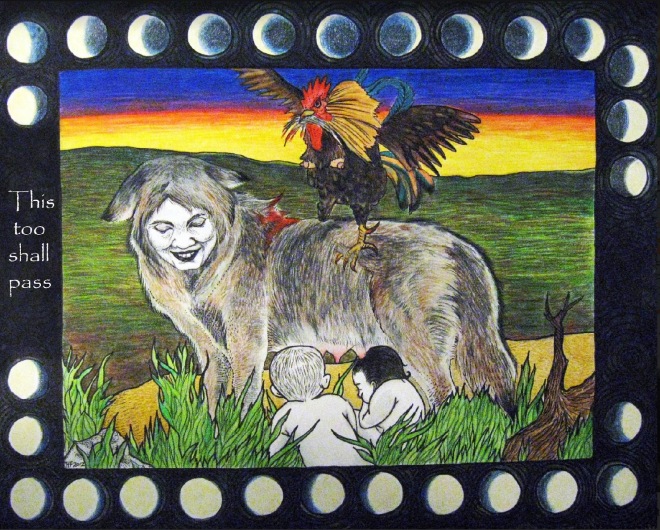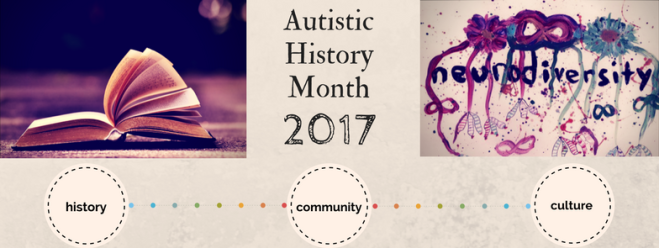Introduction
by Kit Mead
Each year, we will share a post on November 30 to close out Autistic History Month. The closing post will follow a theme each year. 2016’s theme centers the importance of preserving autistic history and how we can use that history to work for change today.
A survey will also go out every year to discover whom the posts reached, and if we changed anyone’s knowledge base of autistic history. This year’s survey is available here: https://goo.gl/forms/FU4k5ay43cMjF3lm2
November comes to a close, with all its tidings of news and current events. Thank you to everyone who submitted to Autistic History Month, those who spread the word, and those who read and shared the posts. Thank you for furthering the knowledge of autistic history, and showing that we have a history. I am the first to admit that I don’t know everything about autistic history. But I worry that many do not know our history, about those missing from it (such as autistics of color), and that we are not preserving it or current events or work of a diverse community.
Knowing history is vital, especially in this time of turmoil for many. Knowing autistic, and other disability history, is vital. If we don’t know how we organized and formed communities in the past, it’ll be harder to organize and sustain community now. We must also preserve our history and current events, and the work of a diverse community. If we don’t, future autistics could lose the chance at an identity backed by cultural history and strength from that. I’ve asked another community member, an autistic historian, to weigh in on the value of knowing autistic history and using it to work for change. Their contribution is below.
Autistic History in 2016: Where are we going and where have we been?
by Sarah Pripas-Kapit
People who don’t know very much about history oftentimes say that we need to study history because it repeats itself. Most historians I know groan at that cliché. In truth, we need to study history because we cannot possibly understand how we got here if we do not.
Such is the case for the autistic community. I’ve been involved with our community for ten years now, and I can say that a lot has changed even during that short window of time. While the neurodiversity movement was alive in 2006, it lacked a lot of the organization and power that it now has. Social media was still in its infancy, and the community was much smaller than it is today. The Autism Hub—where I blogged for several years—was the center of the online neurodiversity community.
Shortly after I joined the community, in 2007, the NYU Child Study Center plastered the New York metropolitan area with hurtful, ableist billboards about autism and other disabilities. Intended as a public service campaign, these billboards actually did a vast disservice to autistic people and people with psychiatric disabilities.
This itself wasn’t anything new. What was new was the fact that we were able to defeat the campaign. Within a few weeks, the billboards were down. Along the way, we earned media coverage in major outlets. Most of the people who read those articles probably never heard the word “neurodiversity” before.
The end of the Ransom Notes campaign hardly marked the end of ableist “awareness” messaging. But it was, nevertheless, an important milestone in our history as a community. Anyone putting together a public services campaign today, nine years after Ransom Notes, would be aware of our existence as a politicized community in a way that the NYU Child Study Center was not.
Of course, 2007 hardly marked the beginning of autistic history. Our community’s history is a long one, and in many ways it is quite complex. The very notion of autism as a concept dates back to Hans Asperger’s work in the World War II era—which is hardly any time at all in the grand sweep of human history. Yet autistic people existed before the autism diagnosis did. These pre-diagnosis histories matter, too.
While there have been several excellent historical works on autistic history penned by non-autistic authors, it is critical that autistic people ourselves participate in the project of autistic history. We need to look not only at Asperger’s and Kanner’s records, but also within the histories of psychiatric institutions, monasteries, institutions of higher learning and more. We need to look at archives across different continents, in different languages, telling stories of autistic people of diverse genders, cultures, ethnicities, religions, and sexualities.
Autistic history is a huge project, and we’re only now getting started.
There is no single history of the autistic community, just as there cannot be a single history of women or LGBTQ people. But—if I can be a total history geek for a moment—that makes the work to be done all the more exciting. If you have any interest in this at all, start joining in this work.
Now I have to provide a few cautionary warnings. It can be tempting to believe that history is an upwards trajectory, with things always getting better and better. Historians call this the “Whiggish view of history.”
Yet the Whiggish view of history oftentimes is not supported by evidence, as I’ve learned in my own studies of the history of women’s medical education in the U.S. Sometimes there are dips and regressions. Sometimes people of the past were more progressive than we give them credit for. Sometimes age-old oppressions are actually newer than we think.
This is sobering news. While the past ten years has been a period of progress for the autistic community, I fear that we may be heading into a period of regression. As so many others have said, the election of Donald Trump to the presidency is looking to be disastrous for people with disabilities. Like many of you, I am concerned about the months and years to come.
History tells us that civil rights are never a done deal. We have to work continually to uphold them.
But I hope that history can also provide hope. We are not the first generation of disabled people to face an ableist state and rollbacks of progress. By looking to the past, we can find a way forward during these turbulent times.
Contributor Bios
Kit Mead is the current admin of the Autistic History Month blog. They are a queer, Autistic disability rights advocate who also has mental health disabilities. Kit’s work on disability, queerness, and mental health has appeared in QDA: A Queer Disability Anthology, Luna Luna Magazine, The Establishment, and The Deaf Poets Society. Kit also writes at their blog, Paginated Thoughts.
Sarah Pripas-Kapit is a freelance writer and editor with longstanding involvement in the autistic community. She holds a PhD in History from the University of California, Los Angeles, where she worked on the international history of women’s medical education. Her work has appeared in Gender & History and Great Plains Quarterly.






